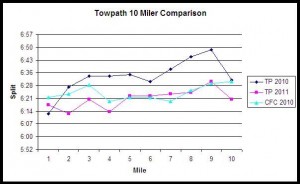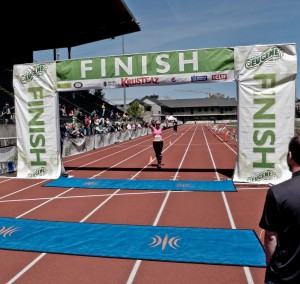Most runners worry about their training and what will happen on race day. It’s normal to care about something as important as a new personal record or fitness milestone. But as much as we fret over our preparation, most runners don’t take the time to learn from our races.
Races are invaluable learning tools. You can analyze exactly what happened, how you felt, and your performance. Here to better help you learn how, is Greg Strosaker of Predawn Runner.
Enter Greg:
In this year of the PR, you hopefully have at least a few races planned. Obviously, without racing, you can’t set new PR’s – well, maybe you can keep track of training records, but that’s not quite the same thing.
Most good training plans have a few build-up races in the mix to help assess your progress and simulate the conditions you’ll experience in your goal race. Or you may plan, say, a spring marathon as a step along the way towards setting your PR in the fall.
While the training, preparation, and execution of a race are important, one element is often overlooked in getting the most value out of the event, and that is the post-mortem, or a formal assessment of your performance on race day.
The Post-Race Analysis
You’ve invested time and ever-increasing amounts of money in such events, so it makes sense to make sure you are extracting as much gains as possible, so taking what should amount to no more than an hour to really analyze your performance seems a worthwhile investment on your road to ever-improving results.
In fact, as opposed to starting with a post-mortem, it is wise to invest some time ahead of the race in setting expectations beyond just a targeted finish time. This starts from the act of selecting races itself. The races you choose to invest your time and money in (and then face losing a little bit of quality training during your recovery) should fit your overall goals. For example, a 5K does little to prepare you for a marathon (other than serving as a good short tempo run), and there’s not much to gain in the post-mortem analysis either.
One strategy that can help you benchmark your performance over time is to select the same race to perform each year, maybe at or near the beginning of your training season so you can determine how effective your base building has been. For example, I’ve taken to running a very flat 10 mile race every Father’s Day to determine what my fitness level is, relative to past years, heading into the fall marathon training schedule.
In addition, it’s important to set the right expectations for your race against which you will evaluate yourself. Ask yourself:
- What impact should the course and weather conditions have on your performance, and how will you adjust your approach accordingly?
- Do you intend to run negative splits, keep the pace steady throughout, or go out quickly and hold on for dear life (note – the latter is only recommended in rare situations)?
- If there are hills involved, how will you adjust your pacing plan?
- If the weather is unusually warm and humid, how will you change your hydration approach?
A good race assessment looks at both qualitative (such as how you felt) and quantitative (the numbers) results. It is probably best to start with the former, and to do so immediately after the race. Let’s start with the very derivation of “post-mortem” – after death. Did you “die” at any point during the race, or were you in control throughout? If the former, at what point did that occur, and how did you adjust afterwards? If the latter, did you leave everything out on the course, or did you have more left in your tank, and thus maybe underperform a bit? It is important to make a mental note of where you feel your race either “came together” or fell apart for when you later go to analyze your pacing.
There are many tools you can use to help develop a quantitative assessment of your race performance, and using such metrics is a powerful way to better understand your strengths and weaknesses. The first and most obvious step, assuming the data is available, is to look at your mile splits from the race. Ask yourself:
- Did you meet your initial race strategy?
- Were your splits steady, or did you fade as the race progressed (or, even better, did you manage to run negative splits, where your second half of the race was faster than the first half)?
- Did you show signs of hitting a wall, where your pace suddenly and permanently slowed?
- What impact did hills have (this source suggests you should expect to lose 20-30 seconds per mile over a 100’ climb and gain 15-20 seconds per mile on a 100’ descent)?
An even better way to apply metrics is on a comparative basis to recent race attempts of a similar distance. This is another benefit of running the same “benchmarking” race every year. By plotting your splits from each race, you can compare how “intelligently” you went out and how well your pace held up later in the race.
For example, the chart below and to the right compares my splits from the 2011 and 2010 Towpath Ten-Ten (10-Miler) races as well as the first 10 miles of a late fall half-marathon from 2010 (CFC 2010). The results show a significant gain in fitness from 2010 to 2011, and that I have recovered pretty well from an early 2011 injury to reach almost the same level of fitness I had in late 2010.
There are online calculators available based on the VDOT approach by Jack Daniels and Greg McMillan’s coaching that can help you predict race times from recent results. Of course, such calculators assume that you have done the appropriate training for the distance, and the further apart the race distances the less accurate the prediction is likely to be (a 10-mile race is far more predictive of your half-marathon performance than a 5K would be). But this is nonetheless helpful in setting goals for future races, as well as establishing the pacing you should be using in your tempo, interval, and easy workouts.
Finally, by looking at the performance of other nearby finishers in the race, especially in your age group, you can get a further sense of what your performance might be at different distances and even if the race was faster or slower than normal. In addition to just Googling the names, you can look at past race results from the same race or use Athlinks to find recent performances. For example, the 2nd place age-group finisher in the above mentioned 10-miler (I took 1st) had run a 2:54 marathon last year, so this gave me better confidence in reaching my own sub-3:00 goal later this year.
As you can see, there are many ways to get better value out of your racing investment by thoroughly analyzing your results. Of course, at some point it is time to move on and focus on what’s ahead (as Jack Welch, former CEO of General Electric, used to say, “yesterday’s news wraps today’s fish”), but you will move ahead smarter and with more intelligent goals if you follow some or all of the steps mentioned above.
What lessons do you draw from your races? How do you analyze your quantitative data (mile splits, warm-up, weather) with qualitative (how you felt)?
Greg Strosaker is the 3:03 marathoner behind Predawn Runner, a blog that provides tips on fitting running into the already-busy life, keeping your motivation high, finding interesting places to run while traveling, and making the most of your training. You can follow Greg on Twitter as @GAStroz, as well as friend him up on Dailymile.
